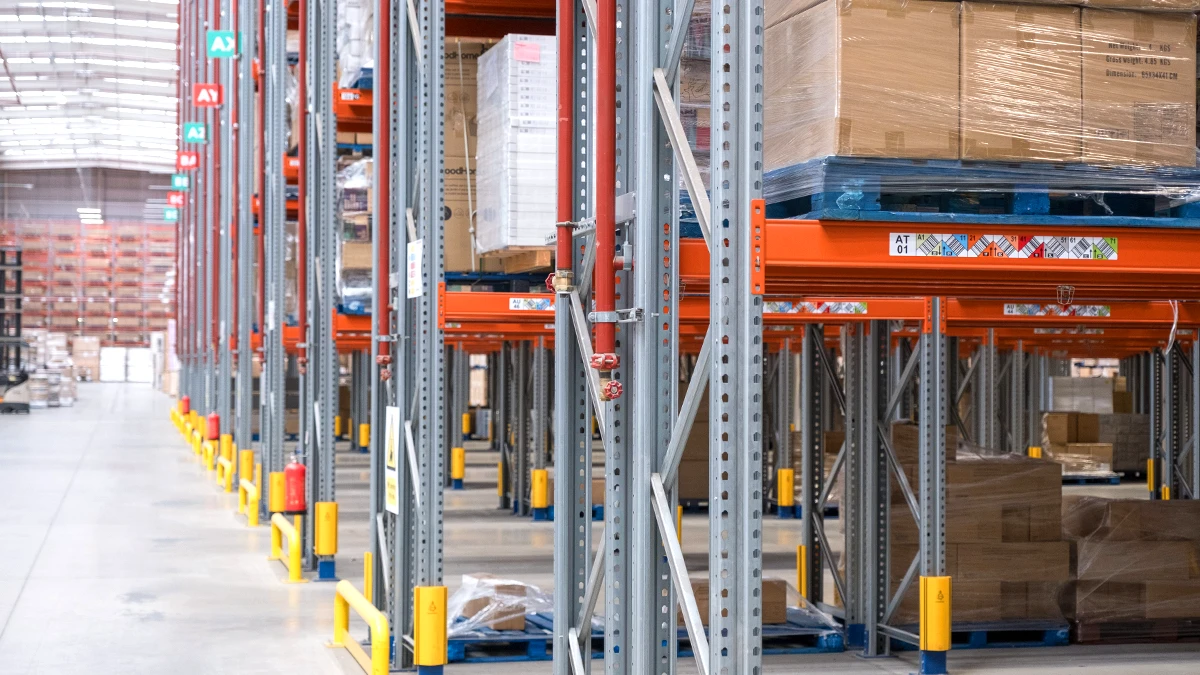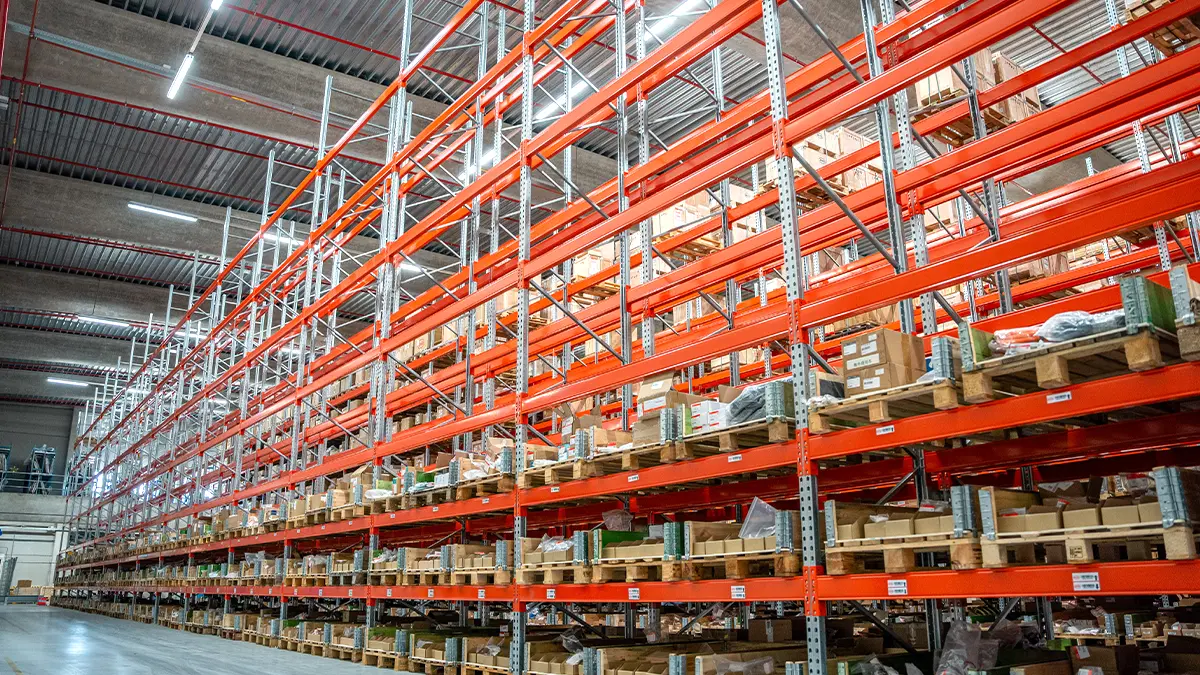The warehouse is a facility or building where a company stores, gathers and manages its products/goods either for its own use or for external use. It is the logistics hub of a company, the centre where a company’s tangible inflows and outflows are managed.
Optimum operational capacity and therefore the profitability of a company largely depend on the storage solution installed. Implementing the right industrial racking system in the warehouse is essential to maximise productivity. However, the safety of the installation and, in particular, workers takes priority for the correct functioning of a warehouse.
As a company specialised in designing, manufacturing, calculating and installing industrial storage and racking systems for all types of loads, AR Racking identifies 7 key elements for maintaining safety in the warehouse.
But what are the main risks that industrial racking systems present in a warehouse? And more importantly, how can damage to the industrial racking systems in a warehouse be prevented? This is analysed in detail below:
What are the main safety risks in a warehouse?
The main safety risks associated with industrial racking in a warehouse are falling loads and transit accidents. These risks may arise for various reasons.
In case of falling loads on walkways or work areas as an industrial racking risk:
- Problems with the design or installation of the industrial racking.
- Modification of original characteristics of the industrial racking.
- Unit load problems.
- Collisions or impacts with the installation.
The main causes of transit accidents that cause impacts between vehicles and/or people circulating in a warehouse are:
- Inadequate lighting throughout the installation.
- Inadequate width of the warehouse walkways.
- Excessive speed or dangerous driving by operators.
What prevention measures can we apply in the pallet racking systems?
Although it is true that there is no such thing as zero risk, companies can implement prevention measures in the racking systems of their warehouse to ensure effective safety conditions. Such measures can apply to the installation, the machinery, training of workers or the protection of industrial racking components.
Prevention measures relating to specifications and design of the storage system:
Firstly, industries should work with a manufacturer/distributor of renowned prestige that ensures compliance with the (EN 15512, EN 15620, etc.) regulations in force on the design and maintenance of industrial racking systems.
And also have appropriate documentation on:
- Installation drawings.
- Racking load plates with performance and characteristics that contain useful information to use the storage system.
- Use and maintenance manual of the storage system installed in the warehouse.
Preventive protection components on the industrial racking systems:
All the storage systems have accessories and components whose installation is recommended to ensure the safety of the racking and therefore the warehouse generally and the personnel who work there. These racking protection components are detailed as follows:
Upright protector
Passive protection accessory on the racking which must be installed at least in transit aisles, tunnels or dispatch areas, with a height of 400 mm or greater.
This is not necessary in work aisle areas or for guided trucks (mechanical or wire guidance).
Safety pins
There are safety pins on each connector (2 per beam). Safety pins are individual elements placed on the connector that joins the beam to the upright and prevents accidental displacement of the beam.
Installation of safety backstops
It is a prevention measure for racking that can either be single or double, and its main function is to prevent the falling of the pallet from racks due to any inappropriate manoeuvre. The rear backstops should not be used for pallet positioning.
They consist of a metal profile set on top of 2 arms bolted to the sides of the uprights.
Installation of the following accessories for storage systems with single base pallets or containers:
Mesh panels
Mesh panels are an element used as a load level to support the goods of the pallets and their different loads. The rectangular mesh is attached to the support bars which gives the structure rigidity. The unit is placed on the beams without the need for extra fixings on the industrial racking.
Meshes can also be installed for manual picking shelving, adapting the solution to the measurements and weights of the products required by each customer.
Support bars
In AR Racking we have three types of support bars for our racking with different functions:
- TM55 support bar for wood: they are especially designed for being able to place on their upper level 22 mm thick wooden boards or chipboard, with the wood flush with the height of the beam.
- T451 support bar: the T451 support bars are structural elements fixed perpendicularly to the beams that enable the placement of pallets on them. They provide an extra level of safety to prevent the falling of pallets in certain situations.
- TNP84 raised support bar: the TNP84 “Top hat” raised support bars enable the entry of forklifts under the unit load. They are used in cases in which loads without pallets or bottom runners are stored. They are the perfect solution for easy loading and unloading.
Supports
Container supports are used when the unit load to be stored are containers with legs at their ends.
It consists of a set of 2 supports crossly arranged on the beams.
Installation of mesh (metal or nylon) in simple alignments with transit of people behind
The protection measures are used as a prevention measure on the industrial racking both at depth and on the sides of the structure. It is a safety element that prevents unwanted displacement or falling of the unit loads.
They can either be nylon or metal depending on installation needs. The flexibility of the nylon type mesh makes it able to fully recover its original state after any incident.
Prevention measures related to the use of industrial racking:
If the company wants to make any changes to the configuration of the storage equipment, the main prevention measure will always be to consult the storage system supplier whose instructions must always be followed in case of recalculating the racking or approving new terms and conditions of use.
It is also important not to forget to remove the unit loads from the racking before making any change and to change the vertical braces if the heights of the beam are altered or the load plates are updated.
Especially important in cases of recovery of racking or inclusion of components recovered from other racking or installations.
We also recommend following the recommendations below on unit loads:
- Check the dimensions of the unit loads. They can affect the clearances for the correct operation of the storage system.
- Check their correct stacking, palletising and filming.
- The pallet must be placed correctly on the beams, pallet beams or support arms.
- The actual design of the pallet enables its centring and correct positioning on the solid block.
Finally, do not forget the importance of the correct operation of the forklift as a prevention measure for the safety of industrial racking in the warehouses:
- The unit loads must be handled with the forklift and suitable accessories for the installation (check with the equipment manufacturer).
- Properly train forklift operators and according to their daily tasks.




